|
 Back to index Back to index
|
| Itineraries > Arrazola Greenway |
|
|

|
At the foot of the fabled Anboto Peak.
The old mining train of Arrazola, with the steam locomotive Aurrera at its head, used to travel down the tranquil water meadows of the river Arrazola to the town of Apatamonasterio.
Today the Greenway allows us to walk the beautiful Vizcayan Atxondo valley from north to south and arrive at the foot of the Anboto Peak, the highest peak of the mountainous Urkiola Natural Park, fabled home of Mari, the ancestral goddess of the Basque people.
|
| WRITE YOUR REVIEW
|
| Technical Data
|
|
 CONDITIONED GREENWAY CONDITIONED GREENWAY
|
Under the gaze of the fabled Anboto Peak
LOCATION
Between the urban district of Apatamonasterio (Atxondo) and the old Errotabarri-El Tope station (Atxondo)
VIZCAYA
Length: 5 Km
Users:  * *  *As an exception to the rule, this Greenway is only open to walkers
*As an exception to the rule, this Greenway is only open to walkers
Type of surface:
Compacted gravel
|
|
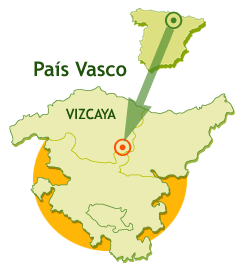 |
|
Natural landscape:
Atxondo: Arrazola river valley and town of Atxondo. Anboto Peak. Urkiola Natural park. Memaia Peaks. Axpe Valley
Cultural heritage:
Atxondo: Marzana district. Towns of Arrazola, Axpe and Apatamonasterio. Mining remains. Apatamonasterio railway station. Scattered watermills, country houses and chapels
Infraestructure:
Greenway. Former terminal station (El Tope). There are rest and recreational areas, public baths, viewing points, water fountains, waste bins, signpost and interpretation panels
How to get there:
Atxondo: Autobuses Pesa. Línea Bilbao-Arrasate/Mondragón
Autobuses Bizkaibus. Líneas Bilbao-Durango-Elorrio y Durango-Arrazola
Connections:
Bilbao: 35 Km from Apatamonasterio (Atxondo).
Further information in the Greenways Guide, volume III
|
|
|
|
| Description
|
|
Km. 0 / Km. 1,6 / Km. 2,1 / Km. 3,5
|
Km 0
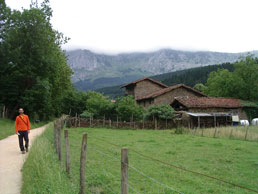 The
municipality of Atxondo or “by the crag”, a
reference to the rocky Anboto Peak, is made
up of scattered country houses and the
villages of Axpe, Arrazola and
Apatamonasterio. As we go through
Apatamonasterio on the BI-4332 road, to our
right we pass the town hall, the church of
San Pedro, and the pelota court; and on our
left, opposite the pelota court, there is a
little square with a thick-trunked tree.
Ziarreta street runs from that square to a
recreation area fitted with benches, a
fitness circuit and a water fountain,
situated next to the shady tunnel of walnut
trees, alders, maples and ashes through
which the river Arrazola flows. This is
where the Arrazola Greenway starts, a
Greenway developed by the Provincial Council
of Vizcaya. The
municipality of Atxondo or “by the crag”, a
reference to the rocky Anboto Peak, is made
up of scattered country houses and the
villages of Axpe, Arrazola and
Apatamonasterio. As we go through
Apatamonasterio on the BI-4332 road, to our
right we pass the town hall, the church of
San Pedro, and the pelota court; and on our
left, opposite the pelota court, there is a
little square with a thick-trunked tree.
Ziarreta street runs from that square to a
recreation area fitted with benches, a
fitness circuit and a water fountain,
situated next to the shady tunnel of walnut
trees, alders, maples and ashes through
which the river Arrazola flows. This is
where the Arrazola Greenway starts, a
Greenway developed by the Provincial Council
of Vizcaya.
From the recreation area a concrete bridge
crosses the river and if we look upstream we
are rewarded with a pretty view of a weir
and a Mediaeval-looking arched bridge. On
the opposite bank a number of paths head off:
to the left a track signposted as a Long
Distance Route (GR); straight ahead, the
trail of the old railway which runs straight
and flat between green meadows.
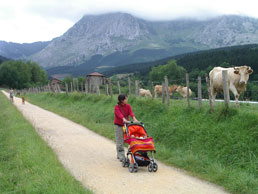 After
a brief journey through meadowland we come
across the river once again, under the shade
of the slender plane trees, alders and ashes
which shelter it. River and railway continue
their idyll side by side for a few more
metres under a dome of hazels and willows.
But on leaving the “tunnel” of vegetation
the rail bed, seeking a straighter route,
abandons the company of the river and moves
towards the mountainside which rises up
sharply on the left. Our eyes are drawn up
the mountainside, attracted by the leafy
vegetation. From the strip of oaks, alders
and ashes which define the lower edge, a
dense pine forest extends upwards to the
Memaia peaks. Further on the Greenway runs
along the left hand side of the broad water
meadow, an area of open ground affording
impressive views of the pine covered hills
on the right which precede the sharply
rising mountain range which extends to the
north east from its highest peak, the Anboto
(1,331 m). After
a brief journey through meadowland we come
across the river once again, under the shade
of the slender plane trees, alders and ashes
which shelter it. River and railway continue
their idyll side by side for a few more
metres under a dome of hazels and willows.
But on leaving the “tunnel” of vegetation
the rail bed, seeking a straighter route,
abandons the company of the river and moves
towards the mountainside which rises up
sharply on the left. Our eyes are drawn up
the mountainside, attracted by the leafy
vegetation. From the strip of oaks, alders
and ashes which define the lower edge, a
dense pine forest extends upwards to the
Memaia peaks. Further on the Greenway runs
along the left hand side of the broad water
meadow, an area of open ground affording
impressive views of the pine covered hills
on the right which precede the sharply
rising mountain range which extends to the
north east from its highest peak, the Anboto
(1,331 m).
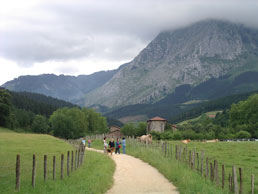 At
km 0.8, tall plane trees line and give shade
to the trail, announcing that we are nearing
Marzaa or Marzana. This, the most important
district of Atxondo, has a central open
space shaded by tall lime trees, surrounded
by the church of San Martín, several large
houses, and a renaissance tower dating from
the 16th century. There is an elegant water
fountain where travellers can quench their
thirst and it’s worth taking a stroll around
this district to enjoy the secluded old
buildings and the Etxezarra country house,
whose gothic door originally came from the
Marzana tower. With regard to the railway,
Marzana used to have a loading platform
serving the mines further up the hill. At
km 0.8, tall plane trees line and give shade
to the trail, announcing that we are nearing
Marzaa or Marzana. This, the most important
district of Atxondo, has a central open
space shaded by tall lime trees, surrounded
by the church of San Martín, several large
houses, and a renaissance tower dating from
the 16th century. There is an elegant water
fountain where travellers can quench their
thirst and it’s worth taking a stroll around
this district to enjoy the secluded old
buildings and the Etxezarra country house,
whose gothic door originally came from the
Marzana tower. With regard to the railway,
Marzana used to have a loading platform
serving the mines further up the hill.
After leaving Marzana behind, the Arrazola
Greenway rejoins the meadowland on the left
bank of the river, crosses the BI-4332 road,
and continues between green hay meadows,
before passing by a recreational area (km
1.3) with toilets, picnic tables and games
for the kids to enjoy.
Km 1,6
After crossing the tree-lined river and its
fresh woody trail for the second time (km
1.6), the broad Arrazola valley narrows. The
steep slopes of the Imietamendi hill (348 m)
gradually throttle the valley until it takes
on the appearance of a narrow gully. In such
a narrow defile the Greenway starts to climb
slightly more steeply alongside a
constricted water course which now spills
rapidly downstream in a series of sonorous,
sparkling cascades under a leafy canopy of
alders.
Km 2,1
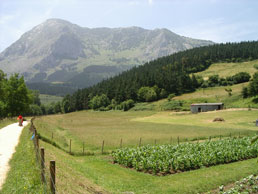 When
we emerge from the defile (km 2.1) we enter
once more a broad green valley, now dotted
with stone built country houses steeped in
years, hemmed in between the Memaia forest
and the limestone peak of the Anboto. Next
the trail rises on a curved embankment to
cross the stream bed which passes through
Axpe, a village which nestles in the valley.
The artificial heights of the embankment,
built to flatten out the route of the
railway, serves as a magnificent viewing
point over the valley. Once across the
stream bed, the Greenway crosses the road to
Axpe where there used to be a level crossing.
Here travellers have the opportunity to turn
left up the road to visit the chapel and the
district of Santiago, where some good
restaurants attest to the fame of Basque
gastronomy. When
we emerge from the defile (km 2.1) we enter
once more a broad green valley, now dotted
with stone built country houses steeped in
years, hemmed in between the Memaia forest
and the limestone peak of the Anboto. Next
the trail rises on a curved embankment to
cross the stream bed which passes through
Axpe, a village which nestles in the valley.
The artificial heights of the embankment,
built to flatten out the route of the
railway, serves as a magnificent viewing
point over the valley. Once across the
stream bed, the Greenway crosses the road to
Axpe where there used to be a level crossing.
Here travellers have the opportunity to turn
left up the road to visit the chapel and the
district of Santiago, where some good
restaurants attest to the fame of Basque
gastronomy.
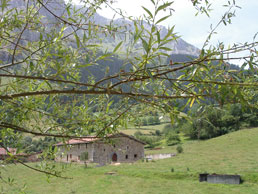 Back
on the Greenway, the climb starts to get
steeper and is cut into the steep valley
side on the right, at some height above the
left bank of the river This section affords
a broad panoramic view of the valley with
its scattered country houses, and also
provides cool in the summer months and,
later in the year, the autumnal colours of
the hazels, oaks, pines, chestnuts and
alders which line the route. The elevated
trail continues along a high and long
embankment leading to a bridge over the BI-4332
(km 3) road, at the entrance to the village
of Arrazola. The bridge, where we can quench
our thirst at a conveniently placed water
fountain, affords us an exceptional view of
the San Miguel bell tower and the Urrutia
country house (16th century), one of the
oldest in Bizkaia given its gothic-renaissance
origins. Back
on the Greenway, the climb starts to get
steeper and is cut into the steep valley
side on the right, at some height above the
left bank of the river This section affords
a broad panoramic view of the valley with
its scattered country houses, and also
provides cool in the summer months and,
later in the year, the autumnal colours of
the hazels, oaks, pines, chestnuts and
alders which line the route. The elevated
trail continues along a high and long
embankment leading to a bridge over the BI-4332
(km 3) road, at the entrance to the village
of Arrazola. The bridge, where we can quench
our thirst at a conveniently placed water
fountain, affords us an exceptional view of
the San Miguel bell tower and the Urrutia
country house (16th century), one of the
oldest in Bizkaia given its gothic-renaissance
origins.
This bridge over the road is also the best
place from which to appreciate the east side
of the Anboto, its steepest side, in all its
majesty. On this side is the “Anbotoko Mari”
cave, legendary home of the Lady of Anboto,
a goddess from Basque mythology who
personifies mother earth. Legend has it that
Mari likes to be in her cave, decorated with
gold ornaments and precious stones,
untangling her long locks with her golden
comb. She has a habit of snatching
disobedient young girls whom she keeps for
seven years while they learn to spin. And
she can change her form at will: sometimes
she appears as a tree with a human face,
sometimes as a woman with the legs of a goat
and the claws of a bird of prey.
Km 3,5
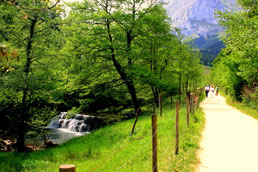 The
Greenway skirts the environs of the town of
Arrazola, high up on the steep hillside,
above the tower and the Ibarra mill (18th
century), the machinery of which still
survives. Then it says goodbye to this town
between attractive orchards, passing by the
Ollargane country house, whose facade bears
the name Pedro de Albayalde and the year
1519, the oldest date inscribed in stone in
Bizkaia. The
Greenway skirts the environs of the town of
Arrazola, high up on the steep hillside,
above the tower and the Ibarra mill (18th
century), the machinery of which still
survives. Then it says goodbye to this town
between attractive orchards, passing by the
Ollargane country house, whose facade bears
the name Pedro de Albayalde and the year
1519, the oldest date inscribed in stone in
Bizkaia.
At the end of this stretch, the rail bed
once again crosses the river Arrazola and
arrives at the San Roque chapel (km 4.5),
just before the head of the Arrazola valley.
Shaded by tall hundred year old plane trees,
there are some benches next to the chapel,
as well as a water fountain and an ample car
park used by the patrons of the restaurant
situated on the other side of the road, in
the impressive Makatzeta country house. The
popular chapel of San Roque features a
shrine with the typical screen of wooden
bars through which the effigy of the saint
can be seen. A sung mass is held in the
chapel as well as a ‘romería’ (pilgrimage)
for San Roque, although in times gone by the
chapel was also used on San Gregorio (May
9), to bless the water which would then be
poured on the land to improve the harvest of
fruits and vegetables.
From the chapel there is a clear view of the
“Ojo de Bentaneta”, a karstic cavity
produced by the action of water on the
limestone rock of the Anboto Peak. They say
that when the sun sets, the Sun King still
gives Atxondo a present of the last ray
through that hole in the rock.
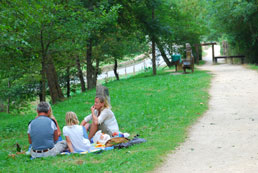 The
trail reaches the final and wildest part of
its route. After the San Roque chapel the
Greenway plunges into the gorge forming the
head of the Arrazola valley, squeezed
between the pasture land that climbs towards
the Anboto Peak and a steep hillside covered
by a leafy woodland of ash, acacia, alder,
birch, pine and walnut, which also give
shade to the traveller. The
trail reaches the final and wildest part of
its route. After the San Roque chapel the
Greenway plunges into the gorge forming the
head of the Arrazola valley, squeezed
between the pasture land that climbs towards
the Anboto Peak and a steep hillside covered
by a leafy woodland of ash, acacia, alder,
birch, pine and walnut, which also give
shade to the traveller.
With such little space, the Greenway and the
crystalline river run side by side until
they reach Errotabarri or El Tope station (km
5), in the vicinity of which are the remains
of some calcining kilns and a small mining
settlement. From the old station, rebuilt
from its ruins to house a recreation area
with toilets, picnic tables and a water
fountain, the more inquisitive of you can
prolong your excursion along the forest
track which plunges deeper into the Arrazola
ravine and, half a kilometre further up,
takes you to the abandoned mines from which
iron and copper was extracted until 1920.
|
|
|
|
|
|
|
|
| Railway History
|
|
The Apatamonasterio to Arrazola mining railway has what must be one of the most impressive sounding names of all our Spanish railways. Founded on the eve of the 20th century, it was in 1903 when the rails of the Compañía del Ferrocarril de Bilbao a Durango were prolonged from its terminal at Durango to a first branch line which took it to Apatamonasterio. This branch line was created for the main purpose of transporting iron ore from the mines at Arrazola to the mighty steelworks of Bilbao. The tracks reached the mines just five months later, in February 1904, and a year later, also starting out from Apatamonasterio, they reached the town of Elorrio, completing a trident of lines at the heart of the Duranguesado rural district.
The railway, originally steam powered, was later electrified, but the stretch from Elorrio quickly became more important than the modest mining spur. The mines reached crisis point in the mid-thirties, which sounded the death knell for this railway as it lost more and more traffic. The last regular goods train ran along these rails towards the end of 1935, and the last passenger train scarcely a year later. The rails were not torn up but were used occasionally, either for carrying mineral ore during sporadic reopening of the mines, or for carrying lumber from any of the forests that lined the line. Like so many other industrial railways, its history eventually petered out and its total demise was finally announced in 1959, while the branch line to Elorrio was closed in the not so distant year of 1975.
|
|
|
|
|
| Links
|
|
Página oficial de turismo del Gobierno Vasco
Página oficial sobre los Centros BTT de Euskadi
Página oficial sobre senderismo en Euskadi
Página de la Diputación Foral de Bizkaia
Página de turismo de la Diputación de Bizkaia
Alojamientos de turismo rural
|
|
|
|
|
|
|
|
